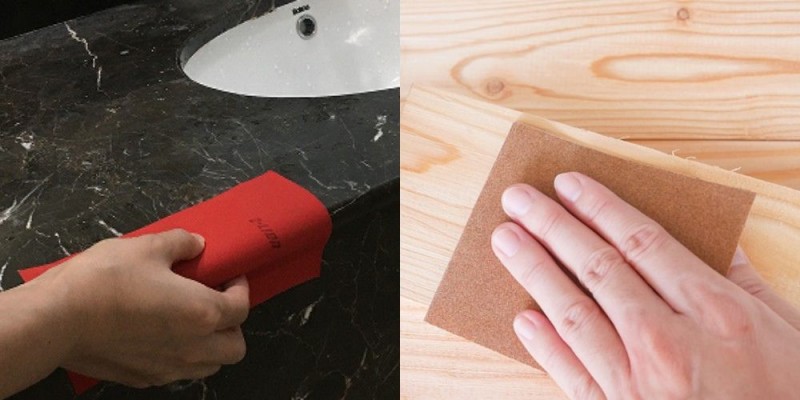Materials are different
Unlike regular sandpaper, diamond sandpaper harnesses the power of synthetic diamond particles. With high hardness and excellent wear resistance, diamond sandpapers have a longer service life.
Traditionally, sanding was a laborious process that often required frequent replacement of worn sandpaper. However, the introduction of diamond sandpapers changed the way materials are smoothed and prepared for various applications. Diamond is known for its exceptional hardness, ensuring that the sandpapers remain effective for a longer period of time. This longevity is key to reducing downtime and increasing overall productivity, making diamond sandpapers the first choice in industries ranging from woodworking to metalworking.
The high wear resistance of diamond sandpapers not only enhances their service life but also improves grinding efficiency. Diamond particles provide consistent wear on a variety of materials, resulting in a smoother surface and reduced time. Additionally, the exceptional durability allows the sandpaper to withstand greater pressure and higher speeds, further optimizing the sanding process. This means increased productivity, cost savings, and process improvements. Additionally, diamond sandpapers offer exceptional versatility, allowing it to handle a variety of applications with ease. Whether you’re sanding hardwood, composites, ceramics, or even concrete, diamond sandpapers deliver superior results. Its ability to handle different materials with ease makes it a popular tool in various industries.
The service life is different
Diamond sandpaper outperforms similar sandpaper in terms of durability, making it the first choice for professionals. Diamond sandpaper owes its strength to the superior properties of its material. Unlike typical sandpaper made of aluminum oxide or silicon carbide, diamond sandpaper has artificial diamond particles embedded into it. These tiny diamonds significantly extend the life of the sandpaper, giving craftsmen a tool that can withstand rigorous use. Research shows that the service life of diamond sandpaper is several times, even dozens of times longer than ordinary sandpaper. This is due to the diamond’s inherent hardness and wear resistance, making diamond sandpaper an investment in the long run.
One of the main reasons craftsmen use diamond sandpaper is its ability to withstand harsh applications without wavering. The exceptional durability of diamond sandpaper allows it to withstand high-pressure sanding and maintain its effectiveness under intense workloads. This not only saves time but also reduces the need for frequent replacements, allowing craftsmen to focus on their projects without interruption. Additionally, the durability of diamond sandpaper can translate into cost savings over time. Although the initial investment may be higher compared to regular sandpaper, the extended lifespan ensures that craftsmen don’t need to make multiple replacements, ultimately reducing expenses in the long run. Additionally, the consistently high performance of diamond paper minimizes waste and maximizes abrasive utilization, making it more cost-effective.
Different scope of application
Diamond sandpaper: Craftsmen working with materials such as marble, ceramics, and cement find diamond sandpaper to be their weapon of choice. The unique hardness and wear resistance of diamond particles make diamond sandpaper ideal for working on hard surfaces. Grinding and polishing hard materials requires abrasive tools that can withstand intense pressure and prolonged use, and diamond sandpaper fits the bill. Its longer service life ensures that craftsmen can continue working without interruption due to frequent replacement.
Regular Sandpaper: Mastering Soft Materials Compared to diamond sandpaper, regular sandpaper is designed to handle the grinding and smoothing of soft materials. Craftsmen working with wood, plastic, and other soft materials rely on the versatility and effectiveness of regular sandpaper. Made from aluminum oxide or silicon carbide, this type of sandpaper excels at providing a smooth surface on these materials.
Proper grit or sandpaper thickness is critical to achieving the desired results. Coarse grits are used for initial rough grinding or removing larger imperfections, while finer grits are used for final smoothing and polishing. Choosing the right grit or sand thickness based on the hardness of the material is critical to avoiding the pitfalls of using sandpaper that is too thick or too fine. Craftsmen must consider the hardness of the material they are working with and choose sandpaper accordingly. Using sandpaper that is too thick for softer materials may remove too much material, resulting in an uneven surface. Conversely, using sandpaper that is too fine for harder materials may not achieve the desired sanding effect.
The process requires precision and efficiency, and choosing the right sandpaper for the job is crucial. Understanding the different application areas of different types of sandpaper can help craftsmen achieve the best results. By harnessing the durability and strength of diamond sandpaper, craftsmen can handle tough materials with confidence, while regular sandpaper becomes the tool of choice for softer surfaces. Choosing the right sand thickness based on material hardness ensures optimal sanding results, optimizing the quality and efficiency of the final surface treatment.
Conclusion
In summary, although diamond sandpaper and regular sandpaper may look similar, they serve different purposes in the grinding and polishing world. The choice between the two depends on the processing material and the desired results. By understanding the differences in materials, service life, and application range, craftsmen can make informed decisions and achieve superior polishing results.
Post time: Nov-23-2023

